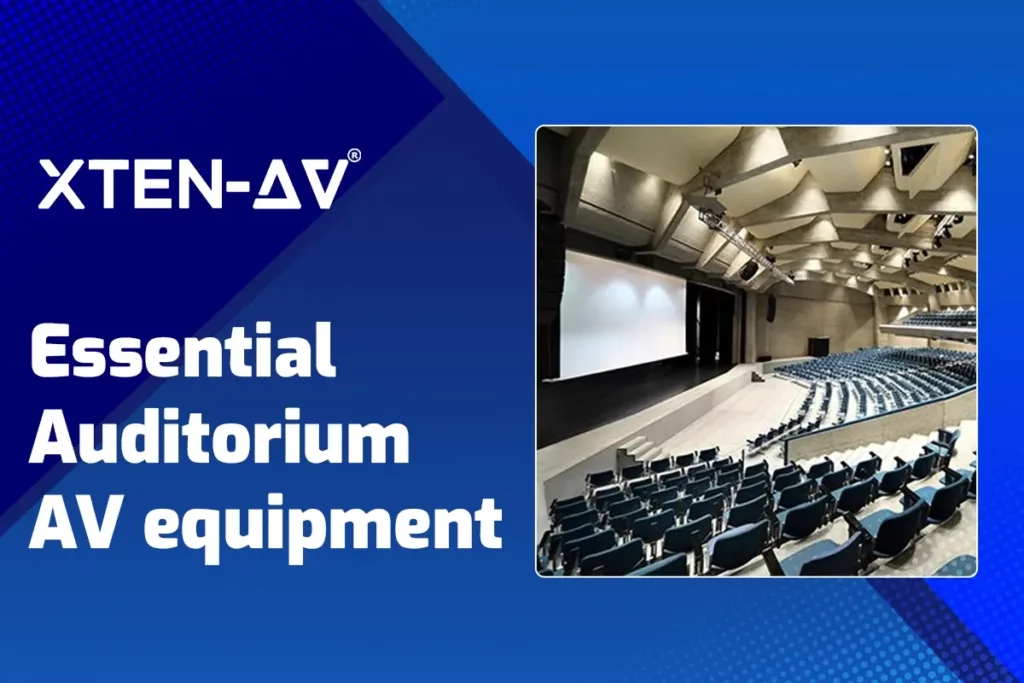Essential Auditorium AV equipment with In-detail Explanation of AV Components
When it comes to AV requirements, choosing the right installations for auditorium space is one of the most complex tasks. Auditoriums require different audio visual device specifications and sizes. Creating an engaging experience for people in the auditorium requires professional audiovisual installations at the correct places to captivate the audience towards the event. Apart from the devices, auditorium installations are incomplete without central console systems for audio, video, lighting, and overall graphics. This article will enlist the important auditorium AV equipment necessary to ensure a successful event.
Key Takeaways
- This article provides a list of essential auditorium AV equipment and an in-depth explanation of the most important AV components for auditoriums.
- You will also learn the important audio, video, and lighting system integrations.
- You will get trivia about the ultimate AV drawing creation software, X-DRAW, which helps you create audiovisual drawings quickly.
List of Essential Auditorium AV Equipment
These are the essential auditorium AV requirements or solutions you need for planning events in the auditorium. However, it is beneficial for you to know the right combination of audio, video, or graphic systems, in particular, to understand the relevance and functioning of the essential auditorium audiovisual equipment.
- HD or advanced projection system
- Video walls or panel displays
- Multi-functional, rotating, and zooming cameras
- Speakers( ceiling and wall)
- Microphones( wireless and podium)
- Integrated Audio Video Console Systems of premium quality
- Custom central console system with touch panel
- Lighting (stage, wall, ceiling) with rotate and follow capabilities
- Digital Signage
HD or Advanced Projection System
HD or advanced projection systems are required for auditoriums to create visuals or cinematic effects on the main stage. These can be used to run important tutorial videos, presentations, and graphic visuals for performances. Projectors, LED displays and LCD displays are commonly used as a main screen AV installation.
Video Walls or Panel Displays
Video walls or panel displays are audiovisual equipment that creates an immersive experience throughout the auditorium to engage the audience. They are installed on the walls of the auditorium to enhance brand image and overall visual appeal.
Multi-Functional Cameras
Multi-functional cameras with tilting and zooming capabilities are installed at various places in the auditorium to capture the live experience for recording and live-streaming purposes.
Speakers
High-quality speakers are usually installed in the auditorium’s walls and ceiling to provide a premium audio experience to the audience. Such in wall or ceiling speakers are usually part of the DOLBY or DTS sound system.
Microphones
Microphones in the auditorium are mostly connected to one system to facilitate control. Hand mics, ear mics, and podium mics are the most commonly used microphones.
Integrated Audio Video Console Systems
Integrated audio-video systems are required in auditoriums to control the audio-visual equipment from one place, minimizing effort and effectively controlling the devices through one console system.
Custom Central Console System with Touch Panel
Auditoriums require a custom-made central console system with a touch panel to monitor, control, and manage all the AV equipment installed in the space. This ensures that every device or system is managed effectively from one place.
Lighting
There is no possibility of conducting an event in the auditorium without effective lighting. Lighting is the soul of an auditorium that adds life to it. Effective lighting for the stage, audience, and the overall auditorium is necessary for a good ambiance as well.
Digital Signage
Digital signage is required in auditoriums to display directions. It is also effective in emergency situations to navigate the exit plan. Moreover, Digital signage displays valuable information for the audience to know about the ongoing event. Ultimately, it is up to the requirements to decide what kind of information or visuals will be displayed on the digital signs.
What Are the Important AV Components for Auditoriums?
Before starting to design auditorium AV equipment, you need to understand the important AV components for auditoriums, which are generally distinguished into three systems.
- Audio System for Auditoriums
- Video System for Auditoriums
- Lighting System for Auditoriums
Audio System for Auditoriums
Audio system requirements in an auditorium are different from those in other venues. Auditoriums require audio equipment such as speakers, woofers, and bass systems to be installed, as well as a central console for the overall audio.
The quality and flow of audio systems create the most impact. This is why you require higher-quality audio equipment and capabilities.
Speakers for auditorium AV equipment are uniformly mounted on the wall and ceiling. An integrated audio control system should operate the flow and quality of the music in the desired spaces.
You can opt for a particular auditorium sound system console or have a universal integrated AV console for all the equipment.
However, it is better to have both for different situations based on the events. You need to have adaptive audio devices with other AV equipment.
You can also set up manual amplifiers for emergency situations. Manual amplifiers act as a backup when digital control systems glitch or fail.
Choose audio systems with higher sound quality, such as DOLBY or DTS.
Video System for Auditoriums
Your video systems include every piece of equipment related to creating, displaying, or recording visuals. Video systems are highly significant for creating an immersive environment in the auditorium.
The integrated video systems for auditorium AV equipment include video walls, cameras, projectors, display screens, and digital signage.
You also require a software subscription to manage and conduct video conferences or one-to-one interactions. Above all, a central video control system is better for managing the graphics and the overall display output. It is ideal to have a Wi-Fi-integrated console system to manage things easily.
However, manual installations of emergency cameras and displays are recommended to continue the event in case the main system fails. Cameras to record visuals on the stage or in the audience must be permanently placed.
Recording cameras must be high-quality and have tilt and zoom functionality. Power outputs near the stage end are needed for press or manual cameras.
Lighting System For Auditoriums
Proper planning is required to install the auditorium’s lighting system. First, you must consider the two modes of lighting: dark and active.
Dark mode is used when auditorium performances are going on in the main stage area. Dark mode lighting installations require adaptive lights on the top of the stage to focus on the performance with roll-out and movable lights. Further, you need to install small LED lights for the walking cue or to showcase the visual alignment of the seating rows and columns. Walls and ceiling lights for dark mode are also important, with one or two movable focus lights to highlight the active audience interactions during seminars. The lighting near the main stage area should be properly placed with still and movable lighting as per the purpose.
Active mode lighting mainly lights the whole auditorium for conferences or seminars that require active participation and visibility of the audience. These lights should be placed on ceilings and walls in such a way that they create minimum glare and eye strain for the audience. For people sitting on the stage or performing, the lighting should be a mix of straight ceiling lights above the stage and the lights focusing on the stage from different areas for better visibility.
You can opt for a lighting console system to manage the lighting easily.
Why Audio Visual Drawing Software is Essential for Auditorium AV System Design?
X-DRAW is an automation software that creates accurate and descriptive audio visual drawings for you in no time.
You can easily craft:
- Auditorium Floor Plan.
- Signal Flow Diagram for AV equipment.
- Automated Ceiling speaker Layout.
As with every other auditorium AV equipment design & integration, you need to get started with your auditorium AV installations and designs.
Using X-DRAW simply means that your data is secure, as it is a complete cloud-based software. This Auditorium audio visual system design software is a one-stop solution for all your AV drawings needs. From design to sales, this audio-visual software has everything you may need in the process. So, no switching to third-party apps from now on.
You can check the best audio visual drawing software, X-DRAW, for its capabilities through its 15-day free trial. NOW!
AV Design Mastery + Winning Proposals = 10x Productivity!
- Automatic Cable Labeling & Styling
- 100+ Free Proposal Templates
- Upload & Create Floor Plans
- 1.5M Products from 5200 Brands
- AI-powered ‘Search Sense'
- Legally Binding Digital Signatures
Conclusion
Now that you know the essential auditorium AV equipment requirements, you can start creating the required designs with X-DRAW. Never compromise on your own ideas and creativity when designing the auditorium. The trivia in this article is to give you the necessary information that helps you in the overall process.
Also, click on the link if you want to understand the overall dynamics of auditorium av system design, which covers all aspects of design creation.
FAQs
There are two mainstream sound systems: DOLBY and DTS. DOLBY is recommended for events with visual aids or projection. However, DTS has better overall sound quality. It is better to choose the auditorium audio visual equipment that serves your purpose.
Projector screens are better auditorium AV equipment for display screens. This is simply because auditoriums require larger screens, and installing a large screen is quite expensive and not practical for overall functionality. Therefore, in terms of purpose, it is better to have a projected screen with the projector mounted on the ceiling.


